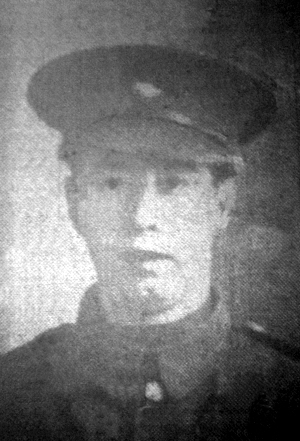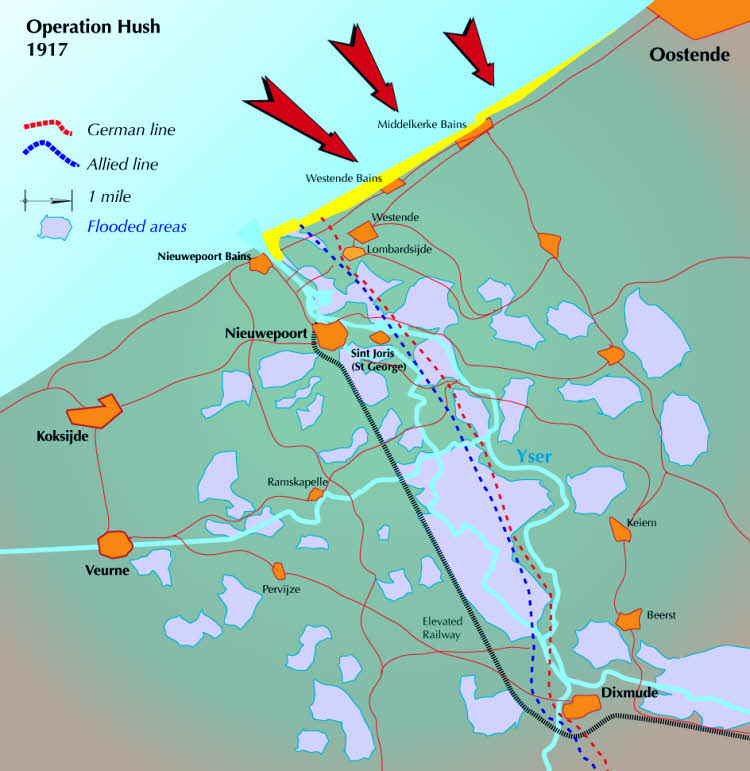
Clifford Hepworth was born in Ossett on the 2nd June 1892 and baptised at Ossett Holy Trinity Church on the 20th July 1892. He was the first child and eldest son of Richard Hepworth and his wife, Annie (nee Bennett) who married at Ossett Holy Trinity Church Ossett on the 24th November 1891.
The couple had seven children in all, three sons and four daughters, all born between 1893 and 1907. In 1901 the family lived on Wakefield Road, Ossett, where Richard worked as an overlooker in a rag warehouse and the four children born by this date were all at school.
In 1911 Richard Hepworth, Annie and their seven children were still living at Wakefield Road, Ossett, now at Sandbed House. Richard was a warehouseman and 18 year-old Clifford was working as a rag grinder. The family remained living at Sandbed House at the time of Clifford’s death.
Clifford Hepworth’s army service record has not survived, but it is known that he enlisted at Ossett and that he was awarded the British and Victory medals. He may have enlisted earlier, but he did not serve overseas before the 31st December 1915 and therefore did not qualify for the 1914/15 Star.
The 2nd Battalion of KOYLI was a regular army battalion and in August 1914 was based in Dublin as part of the 13th Brigade in 5th Division. On the 16th August 1914, the Battalion landed at Le Havre and on the 28th December 1915 the battalion transferred to 97th Brigade in 32nd Division.
2nd Battalion, KOYLI had been in France with 13th Brigade, 5th Division, since August 1914, participating in Mons and the subsequent retreat, Battle of the Marne, Battle of the Aisne, the La Basee front, moving north to participate in the First Battle of Ypres.
Private Clifford Hepworth was killed in the ‘Battle of the Dunes’ or the German attacks on Nieuport on the Belgian coast between the 10th and 11th July 1917. The Belgian Army had manned this sector throughout the war except for a brief period in the Spring/Summer of 1917. Following their flooding of the area by the opening of the Nieuport sea locks and sluices whilst under fire, the Belgians had maintained a bridgehead on the northern riverbank of about a mile in depth.
The British took over the area around Nieuport in preparation for a push up the coast to capture or stop the main U-Boat base of Brugge and the seaward end of the Brugge canal at Zeebrugge, which was planned to be in conjunction with the Passchendaele offensive further inland.
It appears that there were difficulties in the British takeover, particularly with poor quality bridges over the river Yser, which meant that artillery support was particularly inadequate. Once the Germans realised what was happening, they launched a pre-emptive strike on 10th July. Their artillery quickly smashed up what bridging there was, leaving the British troops isolated in the sand dunes, which covered all this part of the coast. Those in the bridgehead were overrun, killed captured or escaped by swimming the river, if they could. As a result the bridgehead was lost and never recovered, that part of the British plan was abandoned. By September 1917, the British had returned that part of the line to the Belgians.
The German attack on the 10th July was by the 3rd Marine Division, led by 30 flame throwers (flammenwerfen), as well as being heavily supported by close-support aircraft that carried bombing and strafing of the British troops and the bridges. About 1200 British POWs and a regimental CO were taken.

Private Clifford Hepworth was killed in action on the 11th July 1917 and is remembered at the Nieuport Memorial,1 Nieuwpoort, West-Vlaanderen, Belgium. Nieuport (now Nieuwpoort) is a town in the Province of West Flanders on the south-west side of the River Yser, 3 kilometres from the sea. The Nieuport Memorial is on a site where the road to Lombardsijde joins the road from Nieuport dock. It is located partly along the “Sluizenring” and partly along the “Westendelaan”.
The Nieuport Memorial commemorates 566 Commonwealth officers and men who were killed in Allied operations on the Belgian coast during the First World War and have no known grave. Twenty of those commemorated served with the Royal Naval Division and were killed or mortally wounded during the siege of Antwerp in October 1914. Almost all of the remainder fell in heavy fighting in the region of Nieuport in the summer of 1917. The memorial is constructed of Euville limestone and stands eight metres high. It was designed by William Bryce Binnie, an Imperial War Graves Commission architect who served with the Royal Highland Regiment during the war and was twice decorated for bravery.
The armies of the German Empire invaded Belgium on 4 August 1914. Within three weeks the fortified cities of Liege and Namur were in German hands and the Belgian forces had retreated to Antwerp, which was well defended and ringed by a series of forts. To begin with, the German First Army under General von Kluck bypassed the city and moved south-west toward the Franco-Belgian border. Yet on September 28, after weeks of heavy fighting in northern France, German artillery batteries began to shell the outer forts from the south-east. The accuracy of the German long-range guns had a devastating effect on the defences of the outer forts, and by the beginning of October the German infantry was slowly closing in on the city.
Fearing that the fall of Antwerp would expose the channel ports and leave Britain vulnerable to attack, the British deployed the newly formed Royal Naval Division to assist their Belgian allies in defending the city. The first British reinforcements, a brigade of Royal Marines, arrived at Antwerp on 4 October and relieved the 21st Belgian Regiment. On the following day the German forces crossed the river Nethe at Lier, 20 kilometres south of Antwerp. Two more British naval brigades arrived at Antwerp early on 6 October, yet while their arrival lifted the morale of the soldiers and civilians in the city, they could do little to alter the strategic position of the Belgian garrison, which was now critical. On the night of 6 October, the Belgian fortress troops under General Paris retired to the inner forts on the outskirts of the city, and over the course of the next day the German forces crossed the river Scheldt and began to shell the streets and houses of Antwerp. By 8 October, the Belgian Field Army had evacuated the city, which was now defended by mixed units of Belgian and British troops. The first German troops entered the city, following heavy shelling, on 9 October and the siege was at an end.
British units did not return to this sector of the Western Front until June 1917, when the 32nd Division relieved French troops stationed at Nieuport in preparation for planned Allied landings on German-held territory along the Belgian coast. German marines launched a pre-emptive attack against the British forces on the river Yser in July and the landings, code named ‘Operation Hush’, never took place. Over 260 men commemorated on the Nieuport Memorial were killed or mortally wounded during heavy fighting with units of the German Marine-Korps Flandern on July 10 1917.
References: